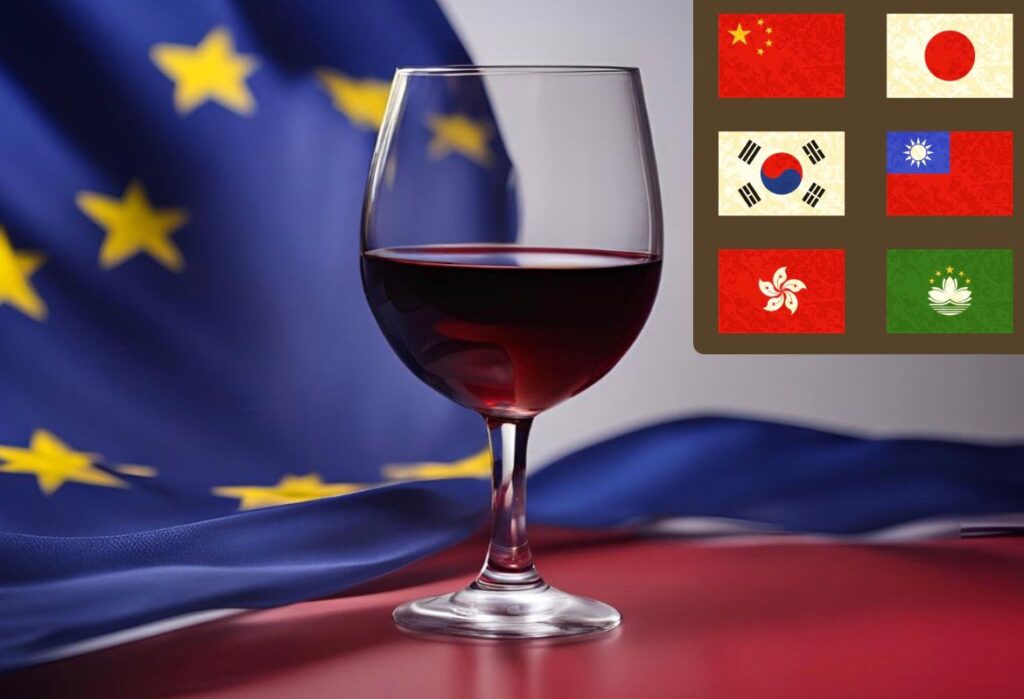As global demand for wine continues to shift, Asia has become one of the most attractive and dynamic regions for growth. For wineries across the European Union (EU), this represents both a major opportunity and a complex challenge. While the continent’s heritage and quality position EU producers favorably, succeeding in Asian markets requires cultural fluency, digital agility, and long-term strategic planning.

A region of rising demand
Wine consumption in Asia is on a steady upward trajectory. With expanding middle classes, increasing urbanization, and a rising interest in Western lifestyle products, countries such as China, Japan, South Korea, Vietnam, and Thailand are becoming key importers of wine—particularly from Europe. EU exports to Asia have grown significantly in recent years, with China and Japan consistently ranking among the top destinations.
Although traditional wine-drinking cultures are still developing in parts of Asia, the appetite for premium and high-quality products is growing rapidly. EU wineries, renowned for appellation systems and craftsmanship, are well-positioned to meet this demand—provided they approach the market with nuance and care.
Telling the right story
For many Asian consumers, wine is still associated with sophistication, celebration, and Western prestige. This creates a unique opening for EU producers to market their wines not just as beverages, but as cultural experiences. Storytelling is crucial—emphasizing the heritage of a winery, its terroir, and artisanal traditions can help brands stand out.
In markets like China, red wine enjoys particular popularity due to cultural associations with good fortune and vitality. In Japan, wine is often appreciated in the context of food pairing. Producers should communicate how their wines complement Asian cuisines, whether it’s a crisp white with sushi or a bold red with grilled meats.
Educating the market
Wine knowledge in Asia varies greatly between countries and consumer segments. In many cases, potential buyers—both retail and trade—may not be familiar with European classifications or grape varieties. To overcome this barrier, EU wineries need to invest in education.
Hosting tasting events, masterclasses, and training sessions for local sommeliers, hospitality staff, and consumers can foster appreciation and brand loyalty. Collaborations with influencers and wine educators who understand both European wines and local markets can be especially effective.
Digital sales and e-commerce growth
Asia leads the world in digital commerce, and this includes wine. E-commerce platforms such as Tmall, JD.com, Rakuten, and Coupang offer powerful distribution channels. These platforms are more than just online stores—they serve as branding ecosystems, with opportunities for livestream events, influencer partnerships, and curated product storytelling.
EU wineries looking to grow their presence in Asia must prioritize digital visibility. That includes developing localized content, engaging with regional social media platforms, and providing digital tasting experiences that help bridge the physical distance between vineyard and consumer.
Local partnerships and distribution
Strong partnerships with local distributors and importers are key to navigating Asia’s fragmented and regulation-heavy markets. These partners offer valuable insights into consumer behavior, pricing strategy, and route-to-market logistics. A well-connected distributor can also help secure premium placement in retail stores, restaurants, and hotels.
Some EU wineries may consider forming exclusive arrangements or joint ventures to maintain greater control over brand representation and marketing.
Sustainability as a selling point
Environmental awareness is increasing among Asia’s younger wine consumers. Labels that emphasize organic farming, sustainability, and low-intervention winemaking are gaining appeal—especially in markets like Japan, South Korea, and Singapore. EU producers who have invested in green practices should make these values visible and part of their branding strategy.
Certifications, eco-friendly packaging, and transparency in sourcing and production methods are now seen as markers of quality and integrity, not just ethical extras.
Face-to-face exposure still matters
Despite digital advances, physical presence at trade fairs and expos remains essential. Events like ProWine Shanghai, Vinexpo Asia, and Wine & Gourmet Japan offer EU producers direct access to distributors, media, and consumers. They also signal commitment to the region and allow wineries to gather valuable market intelligence.
Navigating challenges
While opportunities abound, EU wineries must prepare for certain challenges. Regulatory complexity, fluctuating tariffs, and logistical hurdles—such as maintaining proper storage temperatures across long shipping routes—require careful planning. Brand protection is also crucial, particularly in China, where counterfeiting has been an issue. Registering trademarks and monitoring distribution channels are necessary steps.
Conclusion: a market worth the investment
Asia offers vast potential for EU wineries, but it rewards patience, adaptability, and cultural understanding. Success goes beyond exporting—it involves becoming part of the local wine culture. By investing in education, embracing digital commerce, forming strong partnerships, and telling compelling brand stories, EU producers can build a strong and lasting presence across Asia.
In a region where wine is still evolving into a mainstream luxury, European producers have the rare opportunity to shape tastes and preferences. For those who get it right, the rewards are not only measurable in sales, but in legacy.